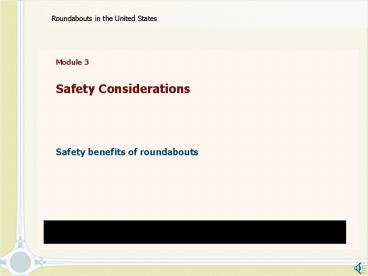Module 3 Safety Considerations - PowerPoint PPT Presentation
Title:
Module 3 Safety Considerations
Description:
Roundabouts in the United States Module 3 Safety Considerations Safety benefits of roundabouts Research has shown there are many safety benefits associated with ... – PowerPoint PPT presentation
Number of Views:169
Avg rating:3.0/5.0
Title: Module 3 Safety Considerations
1
Module 3 Safety Considerations
Roundabouts in the United States
- Safety benefits of roundabouts
Research has shown there are many safety benefits
associated with roundabout intersection design.
2
Safety is a major consideration on our highways
and roadways
In the year 2003 there were an average of 6,850
motor vehicle crashes per day at intersections in
the United States.
PHOTOGRAPHY SOURCE Fred Ranck
For transportation professionals, safety is a
major concern.
3
Intersections are the scene of many accidents.
Transportation professionals are always looking
for ways to reduce the number and severity of
crashes.
4
What is the effect on crash rates after an
intersection is converted to a roundabout?
Conventional 4-way Intersection
Roundabout
Data from 55 intersections with at least 2 years
of crash data before and after conversion of the
intersection to a roundabout.
5
What is the effect on severe injury rates after
an intersection is converted to a roundabout?
Data from 55 intersections with at least 2 years
of crash data before and after conversion of the
intersection to a roundabout.
6
How do typical types of crashes compare between
conventional intersections and roundabouts?
7
How do typical types of crashes compare between
conventional intersections and roundabouts?
8
How do typical types of crashes compare between
conventional intersections and roundabouts?
AWSC intersection
Roundabout
9
How do typical types of crashes compare between
conventional intersections and roundabouts?
10
How do typical types of crashes compare between
conventional intersections and roundabouts?
11
How do typical types of crashes compare between
conventional intersections and roundabouts?
12
Typical types of crashes at roundabouts
Entering
13
Typical types of crashes at roundabouts
Exiting
14
Typical types of crashes at roundabouts
Examples of Loss of Vehicle Control
15
Typical types of crashes at roundabouts
16
Bicycle and Pedestrian Considerations
Intersections also introduce concerns for
transportation professionals on the safest way to
accommodate pedestrians and cyclists.
17
Pedestrian Considerations at Roundabouts
Data on pedestrian/motor vehicle crashes is very
limited.
18
How do typical types of pedestrian/motor vehicle
crashes compare between conventional
intersections and roundabouts?
Motor vehicles conflict with pedestrians in the
crosswalk areas and can occur as the vehicles
enter or leave the intersection from several
different directions.
A roundabout allows a pedestrian to observe motor
vehicles from one direction at a time as they
cross the travel lanes.
19
Pedestrian Considerations at Roundabouts
Personally, I love them, . . . you only have to
stop one lane of traffic, then go to the middle
and wait. The cars cant go much faster than 20
mph through the roundabout so the crossing aspect
is great From the Howard-SuamicoDenise Haltom,
School Crossing Guard, Suamico, Wisconsin
PHOTOGRAPHY SOURCE Lee Rodegerdts
20
Bicycle Considerations
21
Cyclist Movements at Roundabouts Circulating as
a Vehicle.
Bike lanes are not recommended within a
roundabout. Instead, cyclists merge with traffic
before entering the roundabout, circulate with
traffic, and then re-enter the bike lane after
exiting.
22
Cyclist Movements at Roundabouts Circulating as
a Pedestrian.
If a cyclist is uncomfortable riding with
traffic, a cyclist can choose to travel instead
as a pedestrian.
23
Summary of the Safety Features of Roundabouts
- Travel speeds generally reduced by traffic
calming effects
- In almost all cases, the total number of crashes
is reduced when a conventional intersection is
replaced with a roundabout
PHOTOGRAPHY SOURCE Lee Rodegerdts
- And more importantly, the number of severe injury
crashes is dramatically reduced due to the
roundabouts common direction of travel and
similar speeds































